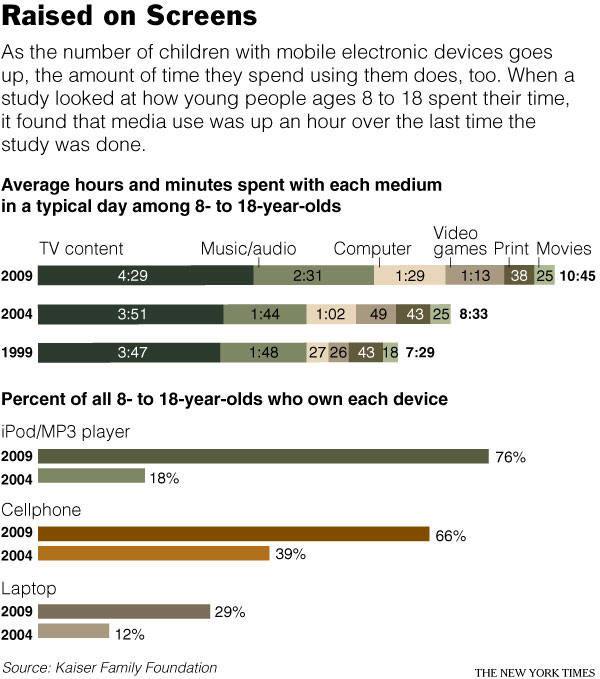http://www.newsweek.com/2010/07/10/the-creativity-crisis.html
In the July 10th issue of Newsweek Po Bronson and Ashley Merryman wrote a fascinating article on the US creativity crisis. Not sure if everyone reading that article sees a creativity crisis, but as an elementary school teacher I found myself nodding my head yes while the article as I have been observing a drop in creativity in our school.
So what is the crisis? Researchers have been measuring child creativity since the late 50s using an instrument called the Torrance test. Like traditional IQ test scores, creativity scores have been climbing steadily due to what researchers account as a more "enriched" environment. However, researchers at William & Mary discovered that this upward trend has stopped. Since the 1990 the creativity scores measured on the same metric are actually dropping. What is most critical is that the scores dropping the most are for younger children...those in K-6. Which just so happens to cover the group of students in my building as well.
So my question (and that of the researchers too) is why have these scores changed? Since evolution is a generally gradual process we know that something environmentally is happening. So what has happened since 1990 that accounts for this downward trend.
My first thought was the "dreaded" NCLB requirements. I have seen creative assignments fall from the curriculum as stakes for test score improvement rise each year. I am not against teacher accountability...I'm just not sure we are measuring what needs to be measured yet. The tests are good at measuring little things like synonyms and antonyms but can't measure a student's substantial application of informational text and appreciation of a poem. I'm sure the NCLB contributes to the decline (at least in my school) but it wasn't law until 2002 and the trend was well underway by then.
Perhaps it was the Internet. Berniers-Lee WWW as we know really started humming along in 1994 which is close to our target date, but the WWW and home broadband access wasn't a household stable for another 6 years or even more in some communities.
The article points at increased television viewing and popular gaming systems as taking at least some of the responsibility for this drop. Since I've never been much of a gamer I wanted to research the introduction of popular gaming systems to see how the timing of their release corresponded. Interesting finding....
- 1986: Nintendo releases the Sega
- 1989: Nintendo releases the Gameboy
- 1995: Sony releases the Playstation
The handheld gameboy timing is interesting. I couldn't find how many units were sold in the first year but according to Wikipedia:
Game Boy and Game Boy Color combined have sold 118.69 million units worldwide...44.06 million in the Americas.
Of course I can make no causal relationship but it is curious. The article does not mention the creativity rates of other countries and whether or not they are dropping, but does mention that some countries such as Britain and China are making a national push for more creativity in the classroom and less reliance on memorization for short term test gains. Coming from Britain that is especially interesting at their children are sometimes called the "most tested" students in the world.
The article also identifies TV viewing as a likely culprit. My brief search for television viewing habits of children from 1990-2010 didn't turn up exactly what I wanted but it did find the media viewing rates from 1999-2009 as published by the Kaiser Family Foundation's Generation M2 survey finding which was published in Jan 2010. (http://www.kff.org/entmedia/upload/8010.pdf) Notice the growth of gaming, TV viewing, and the decreasing proportion of time spent on print activities.
If you are in education you have undoubtedly seen the stories how game play can help creative thinking and problem solving when they are well designed. Unfortunately not all games are well designed engaging experiences. However, I can't recall an article discussing any link to TV and creativity. Actually my brief search reveals the opposite....TV viewing has few redeeming qualities when it comes to creativity. (esp. the younger the child the worse). At least gaming is somewhat participatory.
So what are we to do as educators?
We spend a substantial time with the youth of America and I think we owe it to them to enhance the amount of creativity we bring into our classroom. Some people will immediately feel we don't have the time (like I have never heard that one before) to get this done in the class. I have to disagree....creativity requires a combination of both convergent and divergent thinking and the ability to shift quickly between the two. Too much of what we do in the name of higher test scores is convergent, choose the correct answer type of work.
The article also mentions ideas of how to structure creative experiences for children. Many people think creativity just happens....while Donald Treffinger over many years and constant revisions has come up with a six stage problem solving model that can help us as teacher plan for these types of experiences in our classrooms.
A great one pager on the stages can be found at: http://www.ettc.net/Intervention/Resources/Forms_Resources/Isaksen%20and%20Treffinger’s%206-Stage%20Problem-Solving%20Model.pdf
Treffinger's Center for Creative Learning can be found at:
I also have a few of his books on hold at the library....as I think his ideas will add to my work in developing technology literacy.





